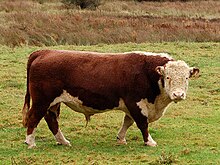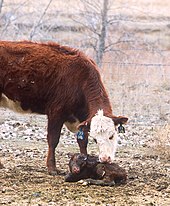Hereford cattle
 Bull near Ufton, in Warwickshire | |
| Conservation status | DAD-IS (2023): not at risk[1] |
|---|---|
| Country of origin | United Kingdom |
| Distribution | more than 60 countries[2] |
| Use | beef |
| Traits | |
| Weight | |
| Height | |
| Coat | red and white |
| Horn status | horned or polled |
| |
The Hereford is a British breed of beef cattle originally from Herefordshire in the West Midlands of England.[3] It was the result of selective breeding from the mid-eighteenth century by a few families in Herefordshire, beginning some decades before the noted work of Robert Bakewell.[4]: 197
It has spread to many countries; in 2023 the populations reported by 62 countries totalled over seven million head; populations of over 100000 were reported by Uruguay, Brazil and Chile.[2] The breed reached Ireland in 1775, and a few went to Kentucky in the United States in 1817; the modern American Hereford derives from a herd established in 1840 in Albany, New York.[4]: 197 [5] It was present in Australia before 1850, and in Argentina from 1858. In the twenty-first century there are breed societies in those countries and in the Czech Republic, Denmark, Estonia, France, Hungary, the Netherlands, Norway, Portugal, Spain and Sweden in Europe; in Brazil, Chile, Paraguay and Uruguay in South America; in New Zealand; and in South Africa.[4]: 198
History
[edit]
Until the 18th century, the cattle of Herefordshire resembled other cattle of southern England, being wholly red with a white switch, similar to the modern North Devon and Sussex breeds. In the 18th and early 19th centuries, other cattle (mainly Shorthorns) were used to create a new type of draught and beef cattle which at first varied in colour, with herds ranging from yellow to grey and light brown, and with varying amounts of white. By the end of the 18th century the white face characteristic of the modern breed was well established, as was the modern colour during the 19th century.[6]
The Hereford is still seen in the Herefordshire countryside today[7] and featured strongly at agricultural shows.[8][9][10] The first imports of Herefords to the United States were made about 1817 by the politician Henry Clay, with larger importation beginning in the 1840s.[11][12]
Polled Hereford
[edit]The Polled Hereford is an American hornless variant of Hereford with a polled gene, a natural genetic mutation selected into a separate breed from 1889.[13]
Iowa cattle rancher Warren Gammon capitalised on the idea of breeding Polled Herefords and started the registry with 11 naturally polled cattle. The American Polled Hereford Association (APHA) was formed in 1910. The American Polled Hereford and American Hereford breeds have been combined since 1995 under the same American Hereford Association name.[14]
In Australia the breed is known as the Poll Hereford.[15][16]
Traditional Hereford
[edit]
Many strains of Hereford have used other cattle breeds to import desired characteristics, which has led to changes in the breed as a whole. However, some strains have been kept separate and retained characteristics of the earlier breed, such as hardiness and thriftiness.[17] The Traditional Hereford is now treated as a minority breed of value for genetic conservation.[18]
Health
[edit]
Eye cancer (ocular squamous cell carcinoma) occurs in Herefords, notably in countries with continued bright sunlight and among those that prefer traits of low levels of red pigmentation round the eye.[19][20][21] Studies of eye cancer in Hereford cattle in the US and Canada showed lid and corneoscleral pigment to be heritable and likely to decrease the risk of cancer.[22] Vaginal prolapse is considered a heritable problem, but may also be influenced by nutrition.[23][24] Another problem is exposed skin on the udder being of light pigmentation and so vulnerable to sunburn.
Dwarfism is known to occur in Hereford cattle, caused by an autosomal recessive gene.[25] Equal occurrence in heifers and bulls means that dwarfism is not considered a sex-linked characteristic.[26]
See also
[edit]References
[edit]- ^ a b c d e Breed data sheet: Hereford / United Kingdom of Great Britain and Northern Ireland (Cattle). Domestic Animal Diversity Information System of the Food and Agriculture Organization of the United Nations. Accessed November 2023.
- ^ a b Transboundary breed: Hereford. Domestic Animal Diversity Information System of the Food and Agriculture Organization of the United Nations. Accessed November 2023.
- ^ Sanders, Alvin H. (1914). The story of the Herefords. Chicago: Sanders Publishing Company. Retrieved 12 July 2009.
- ^ a b c Valerie Porter, Lawrence Alderson, Stephen J.G. Hall, D. Phillip Sponenberg (2016). Mason's World Encyclopedia of Livestock Breeds and Breeding (sixth edition). Wallingford: CABI. ISBN 9781780647944.
- ^ "Early Chronology of the Hereford Breed 1723-1955". The Hereford Herd Book Society. 1995. Retrieved 5 April 2010.
- ^ Trow-Smith, Robert (1959), A History of British Livestock Husbandry 1700–1900, Routledge and Kegan Paul, pp 100–103.
- ^ "Hereford Cattle, Ashford Carbonel (C) Richard Webb". www.geograph.org.uk.
- ^ "National Hereford Show (C) Richard Webb". www.geograph.org.uk.
- ^ "Here comes the judge (C) Richard Webb". www.geograph.org.uk.
- ^ "National Hereford Show (C) Richard Webb". www.geograph.org.uk.
- ^ Miller, Timothy Lathrop; Sotham, William H. (1902). History of Hereford Cattle: Proven Conclusively the Oldest of Improved Breeds. Chillicothe, Missouri: T. F. B. Sotham. p. 146.
- ^ George, Milton, ed. (1886). The Western Rural Year Book, a Cyclopedia of Reference. Chicago: Milton George. p. 247.
- ^ Roberts, David (1916). Cattle Breeds and Origin. Waukesha, Wisc.: David Roberts. pp. 131–32.
- ^ "Associations merge" Archived 3 October 2014 at the Wayback Machine. Retrieved 1 October 2014.
- ^ "Cattle breeds: Poll hereford". NSW Department of Primary Industries. 13 September 2007. Retrieved 30 October 2022.
- ^ Price, Jack (31 July 2019). "Red Centre cattle property Mt Skinner sold to South Australian family for almost $10 million". ABC News. Retrieved 30 October 2022.
- ^ "Traditional Hereford Breeders Club". www.traditionalherefords.org.
- ^ "British Rare Breed Survival Trust watchlist: Traditional Hereford". Archived from the original on 20 January 2010. Retrieved 7 October 2010.
- ^ H R Guilbert; A Wahid; K A Wagnon; P W Gregory (1948). "Observations on pigmentation of eyelids of Hereford cattle in relation to occurrence of ocular epitheliomas". Journal of Animal Science. 7 (4): 426–9. PMID 18891533. Retrieved 5 April 2010.[permanent dead link]
- ^ R R Woodward; Bradford Knapp, Jr (1950). "The Hereditary Aspect of Eye Cancer in Hereford Cattle". Journal of Animal Science. 9 (4): 578–81. doi:10.2527/jas1950.94578x. PMID 14794577. Archived from the original on 25 July 2008. Retrieved 5 April 2010.
- ^ Gerry Watt (January 2006). "Eye Cancer in Cattle". Retrieved 5 April 2010.
- ^ D. E. Anderson (1991). "Genetic Study of Eye Cancer in Cattle". The Journal of Heredity. 82 (1): 21–26. doi:10.1093/jhered/82.1.21. PMID 1997589.
- ^ A Study of Vaginal and Uterine Prolapse in Hereford Cattle[permanent dead link] Retrieved 22 December 2009.
- ^ 81st Western Veterinary Conference: Medical and Surgical Management of Vaginal Prolapse in Cattle Archived 15 July 2011 at the Wayback Machine Retrieved 22 December 2009.
- ^ W. H. Smith and L. A. Holland. "Dwarfism in Beef Cattle". Dwarfism in Beef Cattle. Proc. Of 41st Annual Livestock Feeders' Day, Kansas State University, Manhattan, KS. N.p.: Kansas Agricultural Experiment Salon, n.d. 34-38. Kansas State University Libraries. Web. 3 November 2016. <http://krex.k-state.edu/dspace/handle/2097/13309>.
- ^ Jan M. Jones and R. D. Jolly. "Dwarfism in Hereford Cattle: A Genetic Morphological and Biochemical Study." New Zealand Veterinary Journal 30.12 (1982): 185-89.
External links
[edit]- World Hereford Council
- American Hereford Association
- Australian Hereford Society
- Canadian Hereford Association
- Irish Hereford Breed Society
- New Zealand Hereford Association
- List of US State/National Hereford Associations
- List of Other International Hereford Associations
- Polled Hereford Breed Information - Cattle.com
- The Origin and Growth of Polled Herefords - Oklahoma State University
- Romanian Hereford cattle Society
